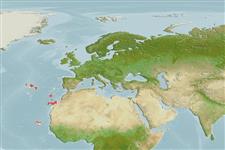Klassifizierung / Names
Namen | Synonyme | Catalog of Fishes(Gattung, Arten) | ITIS | CoL | WoRMS | Cloffa
>
Anguilliformes (Eels and morays) >
Muraenidae (Moray eels) > Muraeninae
Etymology: Muraena: Latin, muraena = morey eel (Ref. 45335).
Eponymy: Auguste Henri André Duméril. (1812–1870) was a friend of Kaup (see Dumeril, AHA). (Ref. 128868), visit book page.
More on author: Kaup.
Environment: milieu / climate zone / depth range / distribution range
Ökologie
seewasser demersal; standorttreu; tiefenbereich 0 - 250 m (Ref. 52678), usually 0 - 50 m (Ref. 52678). Subtropical; 40°N - 14°S, 32°W - 13°W
Eastern Central Atlantic: restricted to the Macaronesian archipelagos.
Length at first maturity / Size / Gewicht / Alter
Maturity: Lm 55.8 range ? - ? cm
Max length : 90.0 cm TL Männchen/unbestimmt; (Ref. 58348); max. veröff. Gewicht: 169.80 g (Ref. 58348)
A nocturnal territorial species found inhabiting rocky and stony bottoms, sometimes hiding under large rocks in tidal pools, from shore to a depth of 250 m, but mainly in shallower depths than 50 m (Ref. 58348).
Jiménez, S., S. Schönhuth, I.J. Lozano, J.A. González, R.G. Sevilla, A. Diez and J.M. Bautista, 2007. Morphological, ecological, and molecular analyses separate Muraena augusti from Mureana helena as a valid species. Copeia 2007(1):101-113. (Ref. 58348)
IUCN Rote Liste Status (Ref. 130435: Version 2024-1)
Bedrohung für Menschen
Harmless
Nutzung durch Menschen
Fischereien: nicht kommerziell
Tools
Zusatzinformationen
Download XML
Internet Quellen
Estimates based on models
Preferred temperature (Ref.
123201): 16.2 - 20.2, mean 19.6 °C (based on 6 cells).
Phylogenetic diversity index (Ref.
82804): PD
50 = 0.5010 [Uniqueness, from 0.5 = low to 2.0 = high].
Bayesian length-weight: a=0.00062 (0.00036 - 0.00105), b=3.29 (3.15 - 3.43), in cm total length, based on LWR estimates for this species & (Sub)family-body (Ref.
93245).
Trophic level (Ref.
69278): 4.0 ±0.6 se; based on size and trophs of closest relatives
Generation time: 6.6 ( na - na) years. Estimated as median ln(3)/K based on 1
growth studies.
Widerstandsfähigkeit (Ref.
120179): niedrig, Verdopplung der Population dauert 4,5 - 14 Jahre. (tmax=17.9; tm=5.3; K=0.178).
Fishing Vulnerability (Ref.
59153): High vulnerability (56 of 100).
Nutrients (Ref.
124155): Calcium = 46.9 [28.7, 95.4] mg/100g; Iron = 0.836 [0.476, 1.359] mg/100g; Protein = 18.6 [16.4, 21.0] %; Omega3 = 0.301 [0.139, 0.774] g/100g; Selenium = 44.2 [23.3, 88.6] μg/100g; VitaminA = 9.87 [2.92, 32.94] μg/100g; Zinc = 0.594 [0.435, 0.836] mg/100g (wet weight);
